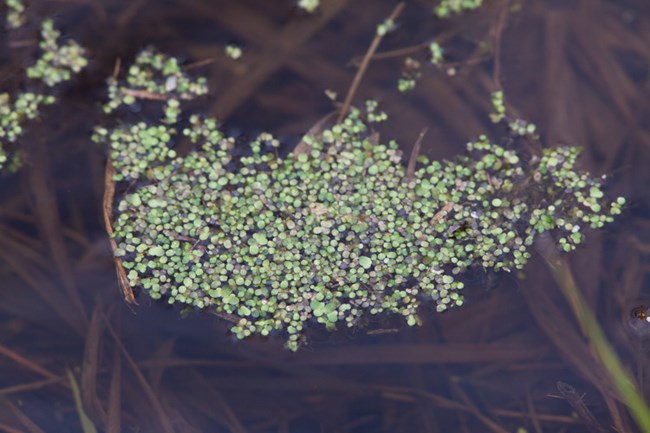
NPS Rivers, Lakes, and Wetlands Home IntroductionThe duckweeds as a group are common throughout the Mississippi National River and Recreation Area. These tiny plants have the reputation of being, if not the smallest flowering plants in the world, certainly one of the smallest. Unfortunately, they rarely bloom so their tiny white flowers are rarely seen. Floating on the surface of the water, the diminutive plant lacks both stems and leaves. Instead duckweed has a small leaf-like body called a “thallus” that contains chlorophyll and often, but not always depending upon species, a tiny root system that hangs vertically in the water column directly below the thallus. Duckweed can be prolific in fertile water and may form extensive mats that can cover the surface of ponds and other still waters. These large accumulations of duckweed are often referred to as “scum” by their annoyed human neighbors, but that is a term that is best applied to mats of algae that form under similar circumstances. Some species of ducks, especially surface-feeding ducks such as mallards, teals, and wood ducks feed extensively on duckweed. Reptiles and amphibians use it for shelter to either hide from predators or to launch ambushes on prey. Some species of dragonflies and damselflies may alight on it to rest or to lay eggs. Tiny protozoans cling to the rootlets, which provide both cover and a substrate on which to find food. Fascinating Facts
Find ItDuckweed is found in most wetlands, especially in areas susceptible to runoff from fertilized yards.Crosby Farm Regional Park Want to Help Us Better Understand the Park?See our iNaturalist project, "The Life of the Mississippi National River and Recreation Area" and contribute to it by downloading the iNaturalist app and uploading your sightings of this species, and others, to the project. You can also upload your sightings from your computer. |
Last updated: March 21, 2018
